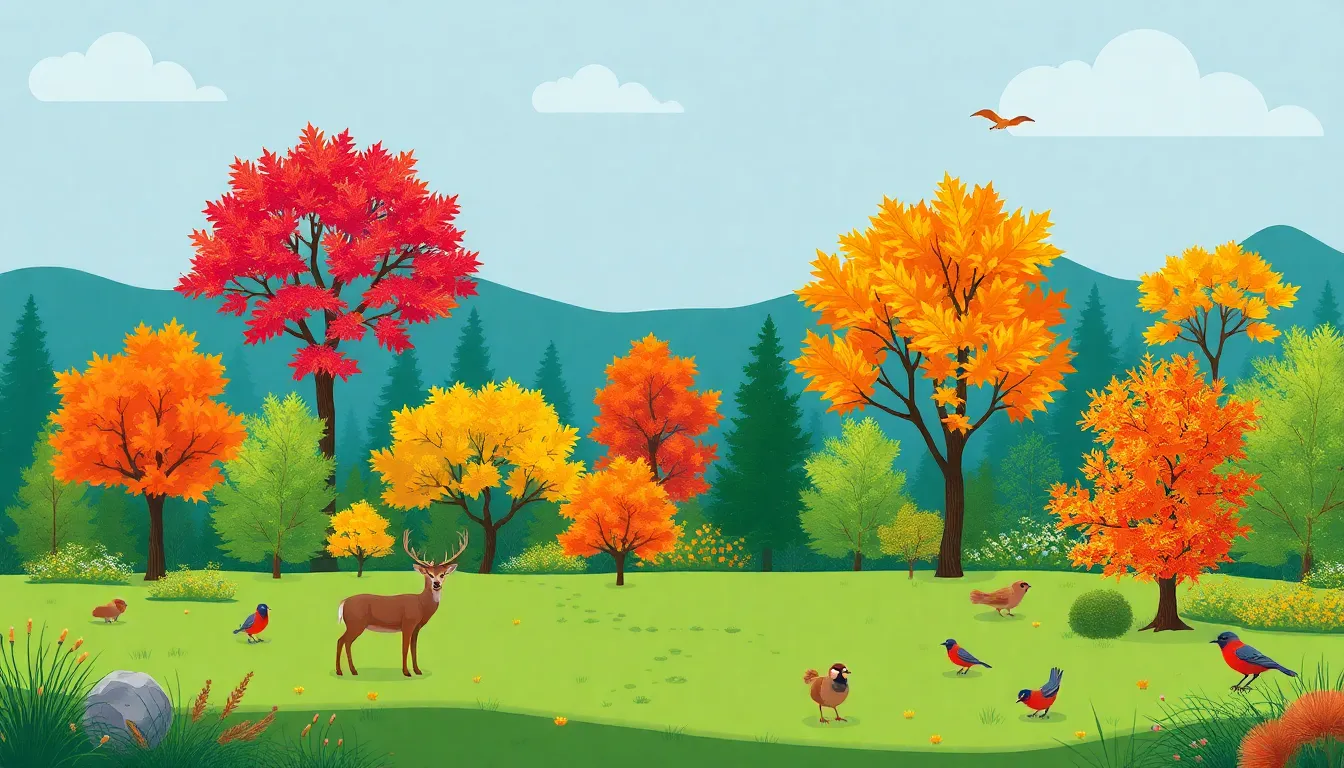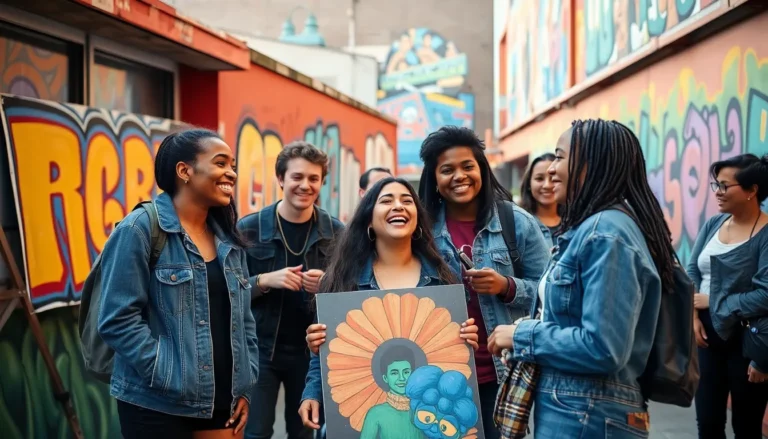Feeling stuck in a creative rut? Don’t worry, it happens to the best of us. Sometimes, all it takes is a spark of inspiration to get those artistic juices flowing. Whether you’re a seasoned artist or just doodling for fun, finding fresh drawing ideas can feel like searching for a unicorn in a haystack. But fear not!
Table of Contents
ToggleInspiration Drawing Ideas
Exploring nature often provides a wealth of drawing ideas. Sketching landscapes, trees, or animals captures the beauty of the environment. Cities and their architecture serve as another source of inspiration, showcasing unique structures and diverse urban scenes.
Character design stands out as a fantastic way to let imagination run wild. Creating original characters can involve blending different traits from various sources. Experimenting with expressions and emotions enhances this process further.
Art challenges facilitate idea generation through specific prompts. Participating in drawing challenges encourages artists to step outside their comfort zones. Joining communities focused on these challenges fosters both accountability and creativity.
Everyday objects pop up as subjects for drawing practice. Capturing items such as fruits, furniture, or tools hones observational skills. Setting up still life compositions can add depth and richness to the artwork.
Fantasy themes invite endless possibilities. Drawing mythical creatures or imagining alternate worlds enables unlimited creativity. Incorporating elements from folklore or personal dreams adds an individualized touch.
Emotions influence visual expression significantly. Artists may depict feelings like joy, sadness, or anger using color and line. Transmitting these emotional experiences on paper captures a viewer’s attention.
Using art history as a reference often sparks new ideas. Studying the styles of famous artists provides insight into different techniques and compositions. Reinterpreting classics with a personal perspective can spark innovative works.
Inspiration manifests abundantly everywhere. By staying curious and open to experiences, artists continually discover fresh ideas for their drawings.
Natural Elements

Natural elements provide abundant inspiration for drawing. Artists can explore various aspects of nature, harnessing its beauty for creativity.
Trees and Foliage
Trees offer diverse shapes, sizes, and textures. With each variety, artists can capture the intricate details of bark and the vivid hues of leaves. Drawing seasonally changes the appearance of trees. Artists may depict blooming blossoms in spring or colorful foliage in autumn. Foliage creates a lush backdrop for landscapes and can stand alone as a subject. Subtleties in light and shadow enhance drawings, making them lifelike. Natural patterns in leaves invite exploration of intricate designs. Each tree species presents unique artistic challenges, encouraging experimentation.
Animals and Wildlife
Animals embody movement and personality. Capturing the essence of various species adds depth to drawings. Artists should study animal behavior, observing their poses and interactions. Wildlife provides opportunities for expressive artwork, showcasing character through fur textures or feather details. Sketching animals in their natural habitats offers context, highlighting the relationship between species and environments. Wildlife encounters inspire dynamic compositions filled with energy. Understanding anatomy improves accuracy in representations, allowing artists to convey grace and agility. Each animal serves as a distinctive muse, invoking creativity across different styles.
Everyday Objects
Everyday objects often spark creativity, transforming mundane experiences into artistic inspiration. Artists can draw from various familiar items around them to enhance their observational skills.
Kitchen Items
Kitchen items present diverse drawing opportunities. Utensils like forks and spoons showcase intricate designs, while fruits and vegetables offer vibrant colors and unique shapes. Plates and bowls provide interesting curves and compositions. Capturing the details of these items allows artists to explore texture and light, enriching their still life studies. Observing how reflections play on shiny surfaces introduces a new layer of complexity to drawings.
Tools and Gadgets
Tools and gadgets serve as excellent subjects for artistic exploration. Items such as scissors, hammers, and brushes exhibit functional beauty. The contrast between smooth and rugged surfaces adds depth to artwork. Drawing small components like screws and gears can enhance understanding of intricate designs. Artists can experiment with perspectives, showcasing tools in use to create dynamic compositions that tell a story. Engaging with these subjects often leads to unexpected creative pathways.
Fantasy Concepts
Fantasy concepts stimulate creativity, inviting artists to explore realms beyond reality. These imaginative themes immerse creators in unique worlds brimming with possibilities.
Mythical Creatures
Mythical creatures spark fascination and invite endless exploration. Dragons, unicorns, and mermaids offer rich narratives and diverse aesthetics. Artists can focus on unique characteristics, like a dragon’s scales or a unicorn’s mane, blending realism with imaginative elements. Creatively combining traits from various creatures yields original designs. Artists might research folklore and mythologies for inspiration, uncovering distinctive features or backstories. Sketching various poses captures the creatures’ personalities, transforming ideas into dynamic illustrations.
Imaginary Landscapes
Imaginary landscapes provide a canvas for boundless creativity. Artists can envision enchanted forests, alien planets, or floating islands that challenge the laws of physics. Emphasis on color and texture enhances the mood and atmosphere of each scene. Practicing perspective brings depth, allowing viewers to experience a journey through these extraordinary settings. Nature’s elements, such as waterfalls and mountains, inspire fantastic formations. Incorporating imaginative flora and fauna enriches landscapes, crafting vibrant ecosystems.
Emotion and Mood
Emotions significantly shape artistic expression. Artists frequently draw upon personal experiences to convey feelings through their work. Capturing the essence of various emotions involves using color, line, and form intentionally.
Capturing Feelings
Capturing feelings in art allows for a deep connection between the viewer and the artwork. Artists often focus on color palettes to evoke specific emotions; warm colors stimulate excitement, while cool tones promote calmness. Varied brush strokes can reflect intensity; quick, sharp strokes communicate urgency, while smooth, flowing strokes induce serenity. Experimenting with abstract representations can amplify emotional depth. Observing how facial expressions influence drawings also enriches the portrayal of complex emotions. Creating artwork that resonates with viewers often leads to profound artistic experiences.
Expressive Portraits
Expressive portraits serve as a powerful way to convey mood. Focus on facial features, as slight variations can dramatically alter the emotion presented. Capturing eyes with importance conveys joy, sadness, or anger instantly. Artists frequently explore body language alongside facial expressions, as posture adds another layer of meaning. Different settings and color schemes enhance the overarching mood of these portraits. Experimenting with different styles, such as realism or abstraction, often reveals new emotional depths. Engaging with subjects personally allows for more genuine and relatable expressions in portraiture.
Finding inspiration for drawing can transform creative blocks into opportunities for growth. By exploring nature urban environments and everyday objects artists can discover endless ideas that spark their imagination. Delving into character design and fantasy concepts opens new avenues for expression while practicing perspective enhances the depth of their work.
Embracing emotions in art allows for genuine connections between the artist and the viewer. Each drawing becomes a reflection of the artist’s journey encouraging a deeper understanding of their craft. Staying curious and open to new experiences is key to continually uncovering fresh ideas. With these insights artists can confidently navigate their creative paths and bring their visions to life.


